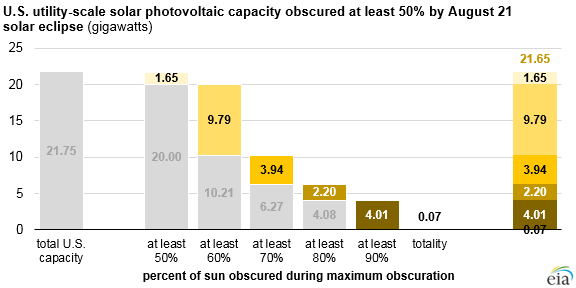The great American eclipse: A total eclipse of the spark?
The next solar eclipse in the United States will occur on Monday, 21 August, the first coast-to-coast eclipse since 1918. Given the growth in the installation of solar PV, how will it affect photovoltaic generation?
The Event and its Forecast Effects
The path of the solar eclipse is shown in Figure 1. It will affect 12.2 million Americans, since 3.8 per cent of the population lives within the path of the total solar eclipse[i].
Figure 1: Eclipse Path

Source: NASA
There is about 43,000MW of grid-connected photovoltaic generation in the contiguous US. The eclipse will take about 90 minutes to traverse the country and it will be last observed in South Carolina at 2:49pm.
Photovoltaic generation - both grid-connected (i.e. large scale) and behind-the-meter (i.e. largely domestic) - will be removed when the sunlight is blocked. The various state electricity systems will experience a sudden (less than 5 minutes) increase in load as photovoltaic generators come off and then a matching decrease in load as the generators return to output.
Figure 2 summarises the effect on US photovoltaic capacity. These supply variations may cause local ramping and balancing issues.
Figure 2: US Utility-scale Photovoltaic Capacity Effects

Source: US Energy Information Administration[ii]
To take the case of California, which will be significantly affected by the eclipse from about 9am until almost noon, solar power may decrease by almost 6,000MW (12 per cent of the state’s peak expected load of 51,000MW[iii]) at a rate of 70MW/minute, and then ramp up by 90MW/minute as the shadow passes. The Californian system’s typical ramp rate is 29MW per minute.[iv] The expected change in solar production is shown in Figure 3.
Figure 3: Anticipated Changes to Californian Solar Production

Source: California Independent System Operator, Solar Eclipse Readiness, 27 July 2017
In Germany, which experienced an eclipse in March 2015, the solar ramp rates following the eclipse were around three times higher than normal, according to TenneT, one of the grid operators[v]. Energy supply in Germany continued uninterrupted even as the supply from solar fell from around 13.3GW at 9:45 in the morning to 5GW an hour later.
In Italy, grid operators were so concerned by the potential impact that they ordered all solar PV systems over 100kW in capacity to shut off for 24 hours.
The next Australian experience
Fortunately there aren’t many major solar eclipses expected in Australia until Thursday 20 April 2023, when the predicted eclipse will have the following parameters[vi]:

However there is a major solar eclipse due on Saturday 22 July 2028, as shown in the diagram below. In Sydney, the major population centre most affected, the eclipse will start at 12:40pm and end at 3:14pm, with a four minute period commencing at 1:59pm when the sun will be 100 per cent covered.
Australia currently has 5,920MW of photovoltaic generation[vii] – about 10 per cent of its total generation capacity.
Figure 4: Eclipse Map, 22 July 2028 Total Solar Eclipse

Source: www.timeanddate.com/eclipse/map/2028-july-22
Conclusion
It will be interesting to see how the North American electricity systems cope with the rapid increase in load followed by a rapid decrease. Solar is an important part of the energy mix in several countries and as its proportion grows (particularly behind-the-meter), new challenges are likely to arise and may not always be easy, or cheap, to resolve for the brief periods of solar eclipses.
Following Germany’s experience, TenneT commented that it will become a lot more difficult to stabilise the grid when less conventional energy is available. Observers have also flagged the potential for fluctuations in Europe of a similar magnitude to an eclipse, with the trigger expected to be ordinary day-to-day weather changes, “like clouds passing over the sun in country X, but not in neighbouring country Y”. It means that as solar continues to grow in the energy mix, rapid fluctuations may not require planetary alignments[viii].
In the case of eclipses at least they are expected events so preparations can be comprehensive – but are electricity systems ready for other unexpected large-scale events, such as solar flares?
[i] Source: www.greatamericaneclipse.com
[ii] https://www.eia.gov/todayinenergy/detail.php?id=32372 accessed 8th August 2017
[iii] North American Electric Reliability Corporation, A Wide-Area Perspective on the August 21, 2017 Total Solar Eclipse White Paper, April 2017, p. 14
[iv] California Independent System Operator, Solar Eclipse FAQ, July 2017
[v] Eric Wesoff, Green Tech Media, 20 March 2015. ‘German and European Power Grids, Civilization Intact Following Solar Eclipse’.
[vi] Source: www.timeanddate.com/eclipse/in/australia
[vii] Source: http://pv-map.apvi.org.au/analyses
[viii] “How Solar-Heavy Europe Avoided a Blackout during Total Eclipse”, Scientific American, 24 March 2015
Related Analysis
The ‘f’ word that’s critical to ensuring a successful global energy transition
You might not be aware but there’s a new ‘f’ word being floated in the energy industry. Ok, maybe it’s not that new, but it is becoming increasingly important as the world transitions to a low emissions energy system. That word is flexibility. The concept of flexibility came up time and time again at the recent International Electricity Summit held in in Sendai, Japan, which considered how the energy transition is being navigated globally. Read more
Nuclear Fusion Deals – Based on reality or a dream?
Last week, Italian energy company ENI announced a $1 billion (USD) purchase of electricity from U.S.-based Commonwealth Fusion Systems (CFS), described as the world’s leading commercial fusion energy company and backed by Bill Gates’ Breakthrough Energy Ventures. CFS plans to start building its Arc facility in 2027–28, targeting electricity supply to the grid in the early 2030s. Earlier this year, Google also signed a commercial agreement with CFS. These are considered the world’s first commercial fusion-power deals. While they offer optimism for fusion as a clean, abundant energy source, they also recall decades of “breakthrough” announcements that have yet to deliver practical, grid-ready power. The key question remains: how close is fusion to being not only proven, but scalable and commercially viable, and which projects worldwide are shaping its future?
Community Power Network Trial: Potential risks and market impact
Australia leads the world in rooftop solar, yet renters, apartment dwellers and low-income households remain excluded from many of the benefits. Ausgrid’s proposed Community Power Network trial seeks to address this gap by installing and operating shared solar and batteries, with returns redistributed to local customers. While the model could broaden access, it also challenges the long-standing separation between monopoly networks and contestable markets, raising questions about precedent, competitive neutrality, cross-subsidies, and the potential for market distortion. We take a look at the trial’s design, its domestic and international precedents, associated risks and considerations, and the broader implications for the energy market.
Send an email with your question or comment, and include your name and a short message and we'll get back to you shortly.



